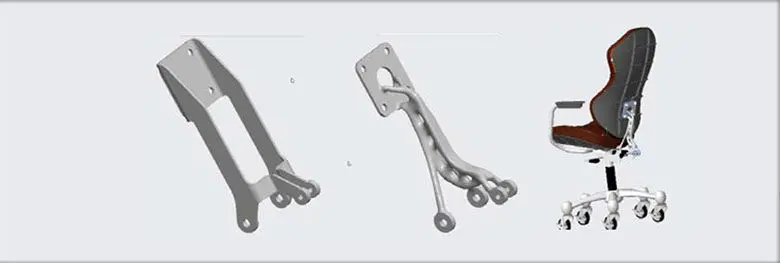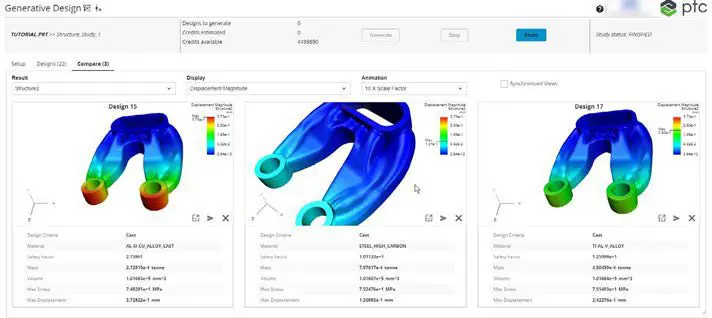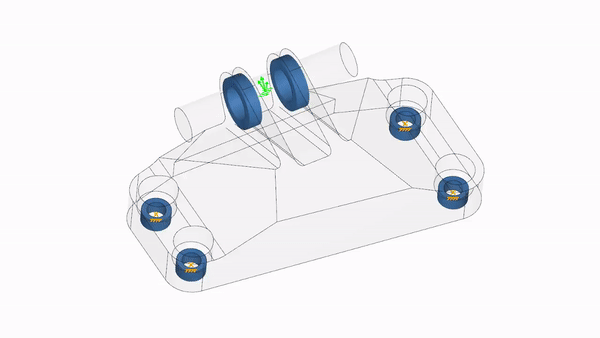October 19, 2022
Best Generative Design Software – Top Choice
READ TIME: 6.8 MINS
Unlocking Your Product Development Potential with The Best Generative Design Software
Generative design is promising to revolutionize products and the way they’re made. Drawing on the strengths of cloud computing and artificial intelligence, the technology creates designs, unlike anything engineers might come up with on their own. Deciding on the best generative design software requires a firm understanding of everything it involves.
How exactly? Here are the basics:
What is Generative Design?
Generative design is a technology in which 3D models are created and optimized by computer software. The process leans on a stack of technologies, including topology optimization and simulation. All these technologies work together, but the engineer remains in control. Using an interactive process, the user sets up requirements for the model, such as manufacturing processes, loads, and constraints. The software will then autonomously produce a set of design alternatives that meet those requirements.
For example: Say your company has the capability to produce a part by milling, casting, or additive manufacturing. Which process and materials are optimal for the part you’re designing? To find the best solution, you can use generative design to show possible combinations of the various materials and manufacturing methods. In the end, you choose the one that best fits your requirements and further refine from there.

That doesn’t mean the designer is off the hook. The generative design process doesn’t replace engineers. Instead, it’s a complement to the design process, and choosing the best generative design software is an important decision. There is still a lot of thought put into weight limits, physical constraints, availability of materials, and so on. The better the engineer defines these different criteria, the better the generative design software can discover possible solutions and help create better more innovative products.
Fortunately, especially for novices, the software can help them explore constraints too. For example, you could set up a design for 3D printing and then try it again with 3-axis milling. From there, decide which result best suits your budget, time schedule, etc., and set that as the optimal solution moving forward.
Choosing the best generative design software means using AI-driven generative design tools that help you deliver more innovative, differentiated products, reduce time to market, and reduce overall product costs.
When Choosing the Best Generative Design Software, Understand What Problems It Solves
The generative design process yields hundreds of innovative design options in a short time—especially if the software is tapping the cloud for computing resources.
It’s then up to the user to evaluate tradeoffs. For example, even though two models meet specifications, option 1 might be lighter, while option 2 is slightly stronger. Both work, but it’s nice to have choices.

(Left) A design for a bracket on an office chair before – and after (middle) – using generative design. (Right) The part in the context of the chair assembly.
The overall benefit is that the best generative design software brings innovative products to market in record time. Though not as immediately apparent, generative design also makes a significant difference to companies that want:
Product differentiation
- Let’s be honest, most designs are based on models that worked before. We make incremental changes and hope it’s attractive to customers. The generative design process allows you to break out of that rut by creating high-performing new parts and products that exceed requirements.
Expert results (even from novice engineers)
- Concerned about the skills gap? An entry-level mechanical engineer can now create a part using the generative design process without extensive knowledge. (And when the system returns hundreds of suitable solutions? Generative design technology can quickly help you filter myriad design options).
Optimized reliability
- Carry out stress analysis on the generative design results to validate the quality and durability of the designs. This ensures your design works in the real world. (It also saves costs in manufacturing and service support).
Improve legacy designs
- Older products may still be functional, but are they optimized? It’s common for engineers to update designs from previous generations. However, generative design may help you find ways to dramatically improve part strength, and reduce overall weight and material use, in legacy designs.

So What is Generative Design Software? A Faster, More Reliable Approach to Design
Imagine you’re a leading manufacturer, and your product designs need months of lead time to produce. New customer demands and competitors are quickly overwhelming you. If innovation doesn’t become a cornerstone of your strategy, it’s all over.
So, what are you going to do?
One idea is to bring artificial intelligence (AI) to bear on your product design process. Generative design is not just a tool, it’s also a powerful approach to product development. To start, your product designers construct a “study.” That is, they define the problem they want to solve, choose the design constraints, loads, materials, and manufacturing methods, and feed those requirements to the software. The software then studies that problem, doing countless iterations, and returns an optimum set of solutions to the product team. The study results are more numerous than the team could have produced on their own. And there are creative design alternatives the team wouldn’t have considered. Even more impressive is that all these designs still meet requirements.

As an engineer, I like right angles, flat surfaces, and round dimensions, and generative design says that may not be the best solution. And so, if I want to be the best possible engineer at my job, I look to Creo generative design to find those kinds of solutions. – Jesse Craft, Sr. Design Engineer & Innovation Project Manager, Jacobs
As an engineer, I like right angles, flat surfaces, and round dimensions, and generative design says that may not be the best solution. And so, if I want to be the best possible engineer at my job, I look to Creo generative design to find those kinds of solutions. – Jesse Craft, Sr. Design Engineer & Innovation Project Manager, Jacobs
As an engineer, I like right angles, flat surfaces, and round dimensions, and generative design says that may not be the best solution. And so, if I want to be the best possible engineer at my job, I look to Creo generative design to find those kinds of solutions. – Jesse Craft, Sr. Design Engineer & Innovation Project Manager, Jacobs
From a strategic point of view, generative design can not only yield higher-quality designs but also enable you to manufacture lighter-weight parts that use less material and show a positive impact on the cost of goods sold (COGS).

GENERATIVE DESIGN SOLUTIONS FOR DIFFERENT MATERIAL OPTIONS
What Makes PTC Creo Generative Design The Best Generative Design Software?
Now that you know what is generative design, by now you understand it’s no secret that generative design and closely related topology optimization tools have been available for a long time. However, workflows with generative design can be more reliable than traditional CAD workflows, and here’s why:
You’re Building Requirements into The Design
All products start with requirements. These requirements could be driven by system engineering models tied to the product’s requirements and managed in PLM. Or you can use requirements you’ve validated yourself during earlier design work. The point is that with generative design, applying requirements to your model is part of setting up your study. Again, every solution that the study returns will meet those requirements.
The Manufacturing Method Informs The Design
Typically, you design a part, validate it using simulation and analysis tools, do some further refining, and then turn the part over to the process engineer for the first of several rounds of feedback before the design is finalized.
Using generative design saves time because you add manufacturing criteria to your study. This ensures you’ve gotten the design off to the best possible start before you call in the specialized expertise of your colleagues.
You Generate Multiple Concepts Quickly
Think back to how you handle the initial design phase. Maybe you come up with a handful of concepts. But if you’re like most professionals, you’re also going to revert to what your experience proves will work, and iterate from there. The best generative design software iterates far faster than humans can, and it does so without a bias towards previous product designs.
You Can Modify the Resulting Model in The Creo Design Environment
The part model that generative design creates produces B-rep (boundary representation) geometry. That means you can work on it in Creo just as you would any of your models.

GENERATIVE DESIGN SOLUTIONS FOR DIFFERENT MATERIAL OPTIONS
The Best Generative Design Software: Creo Generative Design
A recent independent market analysis firm, ABI Research, recently named PTC Creo Generative Design an industry leader in the best generative design software when evaluating options on two criteria – Innovation and Implementation.
Based on the criteria, PTC Creo was named Top Innovator in the 5 assessed areas:
- Greatest ease of use in design setup and updates
- Most generating design options, automation, and design validation/performance
- Best solution accessibility and usability
- Best overall digital thread strategy including VR/AR support
- Most frequently updated technologies and new releases
In Implementation, PTC Creo was also named Top Implementer in the 5 assessed areas:
- Highest usage levels and revenue
- Greatest industry experience
- Largest geographic spread
- Best go-to-market strategy
- Largest education initiatives and value-add services
The choice is clear if you’re looking for the leader in the best generative design software, Creo is the highest ranked in a fully capable CAD system. Offering the highest level of innovation and implementation among competitors.
If you’re not yet using generative design in your work, what are you waiting for? There’s never been a better time to implement it! Learn more about the industry-leading best generative design software now.
TriStar Digital Thread Solutions welcomes questions. Feel free to CONTACT US if you can’t find what you’re looking for, or call us at 800-800-1714









Leave A Comment